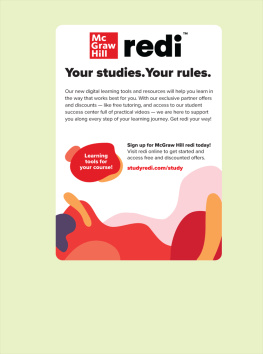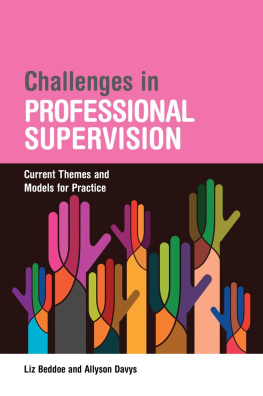Davys Allyson - Best Practice in Professional Supervision, Second Edition
Here you can read online Davys Allyson - Best Practice in Professional Supervision, Second Edition full text of the book (entire story) in english for free. Download pdf and epub, get meaning, cover and reviews about this ebook. year: 2020, publisher: Jessica Kingsley Publishers, genre: Politics. Description of the work, (preface) as well as reviews are available. Best literature library LitArk.com created for fans of good reading and offers a wide selection of genres:
Romance novel
Science fiction
Adventure
Detective
Science
History
Home and family
Prose
Art
Politics
Computer
Non-fiction
Religion
Business
Children
Humor
Choose a favorite category and find really read worthwhile books. Enjoy immersion in the world of imagination, feel the emotions of the characters or learn something new for yourself, make an fascinating discovery.
- Book:Best Practice in Professional Supervision, Second Edition
- Author:
- Publisher:Jessica Kingsley Publishers
- Genre:
- Year:2020
- Rating:4 / 5
- Favourites:Add to favourites
- Your mark:
- 80
- 1
- 2
- 3
- 4
- 5
Best Practice in Professional Supervision, Second Edition: summary, description and annotation
We offer to read an annotation, description, summary or preface (depends on what the author of the book "Best Practice in Professional Supervision, Second Edition" wrote himself). If you haven't found the necessary information about the book — write in the comments, we will try to find it.
Davys Allyson: author's other books
Who wrote Best Practice in Professional Supervision, Second Edition? Find out the surname, the name of the author of the book and a list of all author's works by series.
Best Practice in Professional Supervision, Second Edition — read online for free the complete book (whole text) full work
Below is the text of the book, divided by pages. System saving the place of the last page read, allows you to conveniently read the book "Best Practice in Professional Supervision, Second Edition" online for free, without having to search again every time where you left off. Put a bookmark, and you can go to the page where you finished reading at any time.
Font size:
Interval:
Bookmark:

Best Practice in
Professional Supervision
Second Edition

A GUIDE FOR THE
HELPING PROFESSIONS
Allyson Davys
and
Liz Beddoe

It is an unfortunate reality that although it is relevant to all fields of human services and has become mandatory in many, the practice of professional supervision is contested and very differently understood and interpreted. Thus we began Best Practice in Professional Supervision (Davys and Beddoe 2010). Ten years later, at the start of this second edition, we again survey the territory of professional supervision. We note that the profile of professional supervision has continued to grow during this time through research, publication and practice. Supervision appears on the practice agenda of people from an increasing range of professional and occupational groups, many of whom do not have supervision as a tradition of practice. That being said, there remains a broad range of understanding about, and practice of, professional supervision (Kelly and Green 2019; Sewell 2018).
At the beginning of our involvement in supervisory education the literature rather unvaryingly focused on the rationale for supervision and the state of supervision during a period of rapid change in health and human services. Students rightly criticized the traditional literature as assuming much more benign and well-resourced health and social care services than was a reality by the late 1980s. This situation has improved in subsequent years where many authors have contributed useful perspectives which acknowledge the impact of the organizational and political climates (Beddoe and Maidment 2015; Bond and Holland 1998; Brown and Bourne 1996; Hawkins and Shohet 1989; Hughes and Pengelly 1997; Noble, Gray and Johnston 2016). Since our 2010 publication of Best Practice Hawkins and Shohet have published their fourth edition and a raft of new books have appeared, for example: Edwards, (2012); Owen and Shohet (2012); Carroll (2014); Falender, Shafranske and Falicov (2014); Noble, Gray and Johnston, (2016); Hewson and Carroll (2016) and Beinart and Clohessy (2017). Publications addressing supervision have thus rapidly grown in both numbers and professional orientation. The publication of The Wiley International Handbook of Clinical Supervision (Watkins and Milne 2014) also represents an important occasion in the history of supervision scholarship. Our own second book, Challenges in Professional Supervision: Current Themes and Models for Practice , (Beddoe and Davys 2016), provided us with the opportunity to explore more recent developments in supervision and to expand on such topics as supervision ethics, difficult conversations in supervision, group supervision, interprofessional supervision and supervisor education.
Supervision, which is believed by some to have its early antecedents in the 17th and 18th centuries, developed into the practice we recognize today during the past 130 years (Grauel 2002). The growth and refinement of supervision have been accompanied by an associated complexity (and richness) of definition and practice as different professional and occupational groups have adopted supervision as one form of professional development and accountability. The result, a malleable concept in search of precise definition (Grauel 2002, p.4), aptly captures one of the key dilemmas for todays practitioners who are faced with a form of professional practice which, for all its similarities, is differently positioned within separate professions, and indeed for some professions is differently positioned across international borders. Carroll (2014), reflecting on this range of understanding, comments that it has required him to consider what he personally believes to be supervision and to consider how supervision differs, and should differ, when practised in any new context (p.4).
Definitions of supervision can be found which describe a continuum of supervision from an evaluative activity linked to organizational purpose (and student development) to supervision as a reflective space where transformative learning develops and enriches practice. In some contexts, supervision is exclusively the domain of the novice or student apprentice, while in other contexts, it is a lifelong process of professional critique and learning. In our writing, we have chosen to use the term professional supervision, not because we necessarily see this term as the best term for what is a complex set of specific relationships and tasks, but rather it is our attempt to distinguish the practice of supervision from a plethora of other terms which describe similar activities but which do not exactly capture our meaning of supervision. Ferguson (2005), in a multidisciplinary text on clinical mentoring and supervision in the allied health professions, provides a broad definition of supervision that works across disciplines and neatly manages to include the practice learning aspect of supervision and to encompass professional development:
Professional supervision is a process between someone called a supervisor and another referred to as the supervisee. It is usually aimed at enhancing the helping effectiveness of the person supervised. It may include acquisition of practical skills, mastery of theoretical or technical knowledge, personal development at the client/therapist interface and professional development. (Ferguson 2005, p.294)
In 2010, we commented on the unprecedented number of publications on the topic of supervision in the helping and health professions over the previous 15 years and, as detailed earlier, we see that this interest and activity have continued in the subsequent ten years. Research on supervision, although possibly still not keeping pace with conceptual material on supervision (Hawkins and Shohet 2006), has nevertheless also grown in the past ten years. While, as Hawkins and Shohet (2012) note, much of the research is situated in North American-based counselling psychology and psychotherapy and focuses on the supervision of trainees, we have also noted an upsurge in social work research from United Kingdom (UK), Canada, New Zealand and Australia which is focused on the experiences of practitioners who engage in career-long supervision.
The published research has a wide focus which has included: evaluation of supervision, supervisory harmfulness, interprofessional supervision, multicultural competence, anti-oppressive supervision, collaboration, supervision as a reflective space, emotion in supervision, stress and resilience. Studies have followed and observed supervisees and supervisors and reported their interaction with each other and with their clients; different models and approaches to supervision have been considered for their applicability to different groups of supervisees and for their compatibility with each other. Ethical practice and ethical supervision have been explored and the power structures and role of the supervisor and supervisee have been critiqued. A critical lens has been applied to supervision to challenge the blind assumptions of power and tradition and, importantly, supervision has been challenged to move to a collaborative model of relating.
Despite this progress, evaluating the effectiveness of supervision remains problematic (Davys et al. 2017). Watkins (2019, p.1), in a systematic review of the clinical supervision research reviews published between 1995 and 2019, concludes that proof for supervision appears to be more proof by association than otherwise, being primarily a product of ex post facto, cross-sectional, correlational study. Many schedules of criteria for evaluation include some form of subjective individual or parallel assessment by the supervisor and/or supervisee, or rates of staff satisfaction, and/or service user complaint. With regard to the two latter criteria, however, it may not be the effectiveness of supervision per se, but rather the organizational culture that ultimately wields the greatest influence over these factors. This is a topic we will discuss . Two questions have typically been asked when evaluating supervision: what has been the effect of supervision on the supervisees and how does supervision benefit clients or service users (Watkins 2011)?
Font size:
Interval:
Bookmark:
Similar books «Best Practice in Professional Supervision, Second Edition»
Look at similar books to Best Practice in Professional Supervision, Second Edition. We have selected literature similar in name and meaning in the hope of providing readers with more options to find new, interesting, not yet read works.
Discussion, reviews of the book Best Practice in Professional Supervision, Second Edition and just readers' own opinions. Leave your comments, write what you think about the work, its meaning or the main characters. Specify what exactly you liked and what you didn't like, and why you think so.








